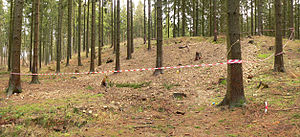Battle at the Harzhorn
| Battle at the Harzhorn | |||||||
|---|---|---|---|---|---|---|---|
| Part of Crisis of the Third Century | |||||||
 Battlefield in southern Lower Saxony, Germany. |
|||||||
|
|||||||
| Belligerents | |||||||
| Germanic tribes | Roman Empire | ||||||
| Commanders and leaders | |||||||
| unknown | unknown | ||||||
| Strength | |||||||
| unknown | unknown | ||||||
| Casualties and losses | |||||||
| unknown | unknown | ||||||
The Battle at the Harzhorn took place in the early 3rd century between Germanic and Roman troops near the Harzhorn hill between the towns of Kalefeld and Bad Gandersheim, in the state of Lower Saxony, Germany.
The battlefield, spanning several square kilometers, was discovered in December 2008 and is currently being excavated. Roman coinage found at the site gives a probable date of the battle to the reigns of Roman emperors Severus Alexander (222 to 235), or Maximinus Thrax (235 to 238).
Archaeologists view the battlefield as a spectacular discovery of extraordinary scientific importance. Along with the Kalkriese battlefield and the Roman camps Bentumersiel and Hedemünden, this is one of the very few Roman archaeological sites in Northern Germany.
Coinage of the Roman emperors Caracalla (211 to 217) and Severus Alexander dates the battle to the 2nd quarter of the 3rd century AD. This places the battle at the junction between the reign of the Severan emperors and the beginning of the Crisis of the 3rd century.
The Roman Empire was governed by the Severan dynasty of emperors from 193 to 235. The reign of the Severan emperors is seen as a last phase of relative stability before the tumultuous era of the Barracks emperors and the Crisis of the 3rd century.
The murder of the last Severan emperor Severus Alexander and the ascension of Maximinus Thrax, a common soldier, to the purple, mark the epoch event of the Crisis of the 3rd century. Over the next 50 years, the Roman Empire would be ruled by some 20 to 25 claimants to the imperial throne, invaded by many foreign enemies (among them the Alamanni, the Goths, and the Vandals), and even split into three competing empires.
...
Wikipedia
